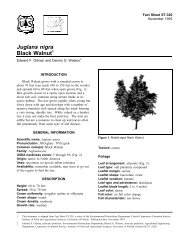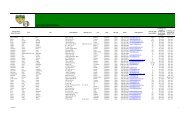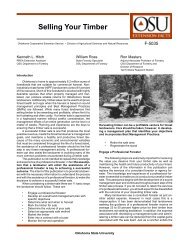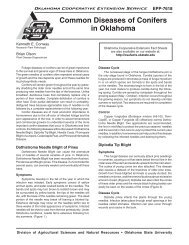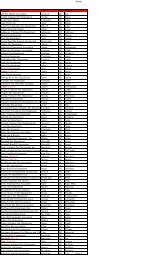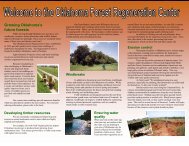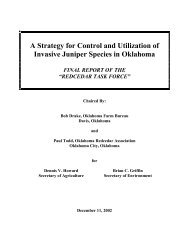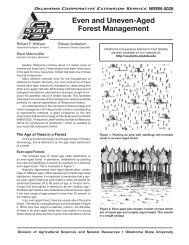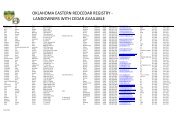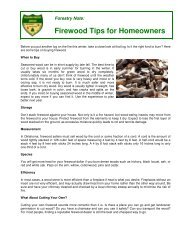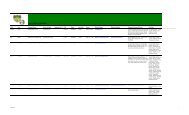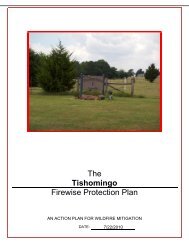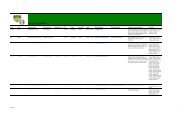Canute - Oklahoma Forestry Services
Canute - Oklahoma Forestry Services
Canute - Oklahoma Forestry Services
You also want an ePaper? Increase the reach of your titles
YUMPU automatically turns print PDFs into web optimized ePapers that Google loves.
The<br />
Town of <strong>Canute</strong><br />
Community Wildfire Protection Plan<br />
AN ACTION PLAN FOR WILDFIRE MITIGATION<br />
DATE: March 2011<br />
Prepared by: Mark Gardner<br />
Organization: South Western <strong>Oklahoma</strong> Development Authority (SWODA)<br />
Contact Information:<br />
Address P.O. Box 569<br />
Phone 580/562-4882<br />
E-Mail markgardner@swoda.org<br />
FAX 580/562-4880
Wildfire Protection Plan: An Action Plan For Wildfire Mitigation 2<br />
The following report is a cooperative effort between various entities. The representatives listed<br />
below comprise the core decision-making team responsible for this report and mutually agree on<br />
the plan’s contents.<br />
Community Representative(s):<br />
Name Phillip D. Root, Mayor<br />
Address P.O. Box 220, <strong>Canute</strong>, Ok 73626-0220<br />
Phone Number 580/472-3111<br />
Other Contact Information canutech@cottonboll.com<br />
Name<br />
Address<br />
Phone Number<br />
Other Contact Information<br />
Name<br />
Address<br />
Phone Number<br />
Other Contact Information<br />
Local Fire Department Representative(s):<br />
Name Jeremy Warnke, Fire Chief<br />
Address P.O. Box 220, <strong>Canute</strong>, Ok 73626<br />
Phone Number 580/563-2406<br />
Other Contact Information rbrinkley@windstream.net<br />
Name<br />
Address<br />
Phone Number<br />
Other Contact Information<br />
Name<br />
Address<br />
Phone Number<br />
Other Contact Information<br />
Local <strong>Oklahoma</strong> Division of <strong>Forestry</strong> Representative(s):<br />
Name Tom Murray, Area Forester<br />
Address Box 569, Burns Flat, Ok 73624<br />
Phone Number 580/562-4882<br />
Other Contact Information 580/331-7319<br />
Name Brian Hall, Staff Forester<br />
Address ODAFF, 2800 N. Lincoln Blvd., <strong>Oklahoma</strong> City, Ok 73105<br />
Phone Number 405-521-3264<br />
Other Contact Information Brian.hall@oda.state.ok.us
Wildfire Protection Plan: An Action Plan For Wildfire Mitigation 3<br />
The following federal and other interested parties were consulted and involved in the preparation of<br />
this report.<br />
Name<br />
Kyle Chervenka<br />
Mary Beth Thomas<br />
Monty Brinkley<br />
Tom Horton<br />
Kevin Merz<br />
Tom Murray<br />
Organization<br />
<strong>Canute</strong> Fire Department<br />
<strong>Canute</strong> Clerk<br />
<strong>Canute</strong> Fire Department<br />
<strong>Canute</strong> Fire Department<br />
<strong>Canute</strong> Public Schools<br />
OK <strong>Forestry</strong> Service
Wildfire Protection Plan: An Action Plan For Wildfire Mitigation 4<br />
PLAN CONTENTS<br />
1. Community Background and Existing Situation<br />
2. Community Base Map and Other Visuals<br />
3. Objectives and Goals<br />
4. Prioritized Mitigation Recommendations<br />
5. Action Plan<br />
6. Wildfire Pre-Suppression Plan<br />
7. Additional Comments<br />
8. Attachments
Wildfire Protection Plan: An Action Plan For Wildfire Mitigation 5<br />
1) COMMUNITY BACKGROUND AND EXISTING SITUATION<br />
Community Description:<br />
County: Washita Latitude/Longitude: 35.422/-99.28<br />
Frontage Road: Interstate 40 Nearest Intersection: Old Hwy 66<br />
Nearest Fire Department (name/location):<br />
Interface Areas:<br />
Map #:<br />
1- Base map<br />
<strong>Canute</strong> Fire Department<br />
WUI on each side of Town<br />
with active railroad<br />
penetrating on the west side<br />
Year Established: 1901<br />
Community Size: 541 – 2000 Census<br />
Number of Lots: 1966 Number of Structures: 275<br />
Estimated Acres: 350 Development Status: Residential<br />
Community Infrastructure:<br />
Home Owners Association/Organization: Yes No If yes, attach a copy of ordinances.<br />
Contacts:<br />
Name Jeremy Warnke, Fire Chief<br />
Address P.O. Box 220, <strong>Canute</strong>, Ok 73626-0220<br />
Phone Number 580/472-3111<br />
Other Contact Information rbrinkley@windstream.net<br />
Name Mark Gardner<br />
Address P.O. Box 569, Burns Flat, Ok 73624<br />
Phone Number 580-562-4882<br />
Other Contact Information markgardner@swoda.org<br />
Resident Population: 541 – 2010 Census<br />
Full Time<br />
Part-Time: 100-75% 75-50% 50-25% less than 25%<br />
Wildfire Hazard Rating: (check one)<br />
Low Moderate High Extreme<br />
Date Evaluated: February 2011 Attach Community Assessment Form.<br />
Community Assessment Highlights (roads, water sources, primary fuel types, utilities and topography)<br />
Located northwestern Washita County, <strong>Canute</strong> is approximately seven miles east of Elk City on I-40 and County Road<br />
N2080 and Old Route 66 runs East to West through town. The post office was established February 24, 1899.<br />
Historian George Shirk asserts that the town is named for King <strong>Canute</strong> of Denmark. The area first opened to non-<br />
Indian settlement in 1892, with the opening of the Cheyenne and Arapaho Reservation.<br />
Ingress / Egress<br />
Access: The main access into town is by way of County Rd2080, which connects to I-40 to the North and Old Route 66<br />
in the middle of town. County RD 2080 continues 9 miles to the south of town and connects to HWY 152. These ways<br />
of access are of hard surface types and are of adequate width as residents are leaving and fire apparatus approaching<br />
from mutual aid request.
Wildfire Protection Plan: An Action Plan For Wildfire Mitigation 6<br />
Signage provides good guidance into <strong>Canute</strong> from each direction. The Major entry into Town would be from I-40. All<br />
entries are well marked and provide all-weather road adequate to handle emergency vehicle access in to all areas of<br />
Town. All major intersections and secondary roads are marked with “post-type” signs.<br />
Subdivision access: With the small size to the Town, it has been divided in two sections. East and West sides with<br />
Main St being the dividing point. All city streets within the subdivisions are of hard surface type with sufficient width for<br />
emergency vehicle access.<br />
Emergency Evacuation: Due to the small size of the Town, emergency evacuation route are likely to be second nature<br />
to the residents. In the East subdivision there are streets that have dead-ends. These streets do not provide adequate<br />
room for safe vehicle turn-rounds without backing into resident’s yards. These areas will be of a major concern for the<br />
larger type of fire vehicles as maneuvering will take time to accomplish. Dependent upon the location of the fire,<br />
emergency communications will be essential in directing residents to the desire evacuation route.<br />
Street Signs: All streets within the community are provided with high visibility, post-type street signs at all intersections.<br />
Most homes are also marked with house numbers that are clearly visible from the street.<br />
Public Fire Protection<br />
<strong>Canute</strong> Volunteer Fire Department: The <strong>Canute</strong> Fire Department is a very aggress and community minded department<br />
that places public safety very high within their membership. With this aggressive nature the Town has a current ISO<br />
rating of a class 5. The department is well equipped to provide fire protection with a fleet of; 3-pumper trucks, 4-brush<br />
type trucks, 2-tanker trucks, 1-service truck and a well equipped rescue truck. The Fire Department provides protection<br />
to the residents with a staff of 20 volunteer firefighters working out of a single station located at 4 th St. and Scheidel<br />
The department augments its capabilities with mutual aid agreements with surrounding fire departments. The<br />
department takes the treat of wildfires very seriously and has procedures in place to respond quickly to any treat of a<br />
wildfire within and well as outside of the City limits.<br />
Water Supply<br />
The Town receives its water by the City Utilities department. The system contains a single 136,000 gallon stand pipe<br />
type storage tank and a total of 7 water wells. This system connects to the distribution system for the town and has<br />
standard type fire hydrant place approximately 600 feet apart. The system has adequate water flow for both structural<br />
fire protection and well as large front wildfires where multiple homes may be threatened.<br />
Utilities<br />
The Town of <strong>Canute</strong> receives its electrical service from AEP with overhead power lines. Natural gas is supplied by<br />
Center Point Energy through underground piping system. There are a few homes in town that use LP gas with storage<br />
tanks close to the structure. These LP tanks are at various locations throughout the town and could pose a threat in<br />
case of a wildfire migrating into the limits of town.<br />
Defensible Space<br />
The town is a farming community in which grassland enters into and surrounds the community on all sides. Although<br />
the homes range in construction dating to the early 1900’s to present, they have good separation. The homes vary<br />
from ordinary wood frame construction with wood and vinyl siding to brick veneer. The town has a mix of hardwood<br />
and evergreen trees throughout the community. Most are well spaced but as common to small towns the trees are<br />
very close to structures with overhanging branches.<br />
High Hazard Areas<br />
All high hazard area noted are on private lands, therefore most mitigation projects are recommendations and<br />
education for land and home owners.<br />
1) North of I-40 and West of N 2080 Rd – Pasture of native grass with Red Cedars. Remove Cedars and provide<br />
fire break of cool weather plants.<br />
2) North of I-40 and East of N 2080 Rd – Pasture of bluestem grass with Cedar trees on the North side. Remove<br />
Cedars and provide fire break of cool weather plants.<br />
3) South of I-40 to the West side of Town is a stand of Red Cedars. Remove Cedars.<br />
4) Railroad Tracks – Overgrown with Johnson grass, and has piles of old cross ties. Visit with Railroad about<br />
removing ties and early spring spraying of herbicides.<br />
5) Lee Ave and 2 nd St – Home has LP tank with pallets staked around and on tank. Remove pallets.<br />
6) South of Public Schools – Pasture of native grass. Provide fire break.
Wildfire Protection Plan: An Action Plan For Wildfire Mitigation 7<br />
7) Beck and Root Propane on NW side of Town and Kilhoffer Propane on SE side of Town. These Companies<br />
themselves do pose a great threat as both have gravel lots and are fenced. Should one possibly be venting<br />
pressure during a wildfire event in close proximity there could be a chance of an explosion occurring.<br />
Community Wildfire History: (include surrounding areas)<br />
Relative Frequency: 30<br />
Common Causes:<br />
Areas of Future Concern:<br />
Additional Comments:<br />
Carelessness, debris burning, lighting, electrical lines arching, sparks from train.<br />
At present time the area is abnormally dry and moderate drought conditions are very<br />
likely. With these conditions continuing the chances of large wildfires are increasing.<br />
2) COMMUNITY BASE MAP AND OTHER VISUALS<br />
See map #1 Base Map.<br />
3) OBJECTIVES / GOALS<br />
Edit as needed to match community needs.<br />
Objectives:<br />
The objectives of this plan/report are to set clear priorities for the implementation of wildfire mitigation in the identified<br />
community. This includes prioritized recommendations for the community as a whole and also for individual homeowners<br />
where appropriate.<br />
Goals:<br />
The goals are fuel reduction and structure ignitability reduction that will protect this community and its essential<br />
infrastructure. It also includes a wildfire pre-suppression plan.<br />
4) PRIORTIZED MITIGATION RECOMMENDATIONS<br />
The following recommendations were developed by the Community Firewise Working Group or Fire Council as a result of<br />
the community wildfire risk assessment and follow-up meetings with local, sate, federal and community stakeholders. A<br />
priority order was determined based on which mitigation projects would best reduce the hazard of wildfire in the<br />
assessment area.<br />
Proposed Community Hazard Reduction Priorities:<br />
List area and treatment recommended.<br />
1. Work with land owners to secure grants for Cedar Tree eradication.<br />
2. Provide fire breaks in grass pastures surrounding the Town.<br />
3. Contact railroad to do spraying of vegetation and remove old crossties from right of way.<br />
4. Excessive tree growth close to homes. Educate home owners as to these hazards.<br />
5. Elevated open decks. Encourage homeowners to enclose with ¼” storm screening or other flame resistant materials.<br />
6. Investigate the possibility of doing prescribed burns on fringe of Town to lessen fire loads
Wildfire Protection Plan: An Action Plan For Wildfire Mitigation 8<br />
Proposed Structural Ignitability Reduction Priorities:<br />
Actions to be taken by homeowners.<br />
1. Remove all firewood from within 30 feet of homes.<br />
2. Enclose elevated decks with storm screening or other non-combustible materials.<br />
3. Prune all tree limbs to a level of 6 feet above ground level.<br />
4. Prune tree limbs that are overhanging home roofs.<br />
5. Clean debris from around home and property.<br />
6. Continue City wide clean-up week.<br />
Proposed Education and Outreach Priorities:<br />
Activities planned and implemented by community, local fire department and Department of <strong>Forestry</strong><br />
1. Educate homeowners about creating defensible space and reducing fuel loads near homes.<br />
2. Begin annual Firewise Day in conjunction with fund raising event<br />
3. Include Firewise information during school visits.<br />
4. Send Firewise information along with water bills.<br />
5. Offer home firewise assessments.<br />
5) ACTION PLAN<br />
Funding Needs:<br />
Outline each project (list highest priority projects first) including estimated cost and potential funding sources.<br />
1. Increase public awareness by placing brochures at City Hall and Bank. Free from OK <strong>Forestry</strong>.<br />
2. Firewise booth during fund raising event. No funds needed information from OK <strong>Forestry</strong>.<br />
3. Apply for grants for Cedar Tree eradication. NCRS<br />
4. School Firewise talks. Materials free from OK <strong>Forestry</strong> Service.<br />
5. Community clean-up week. City to continue to supply large refuge boxes.<br />
6. Equipment to do prescribed burning projects. Undetermined cost.<br />
Timetables:<br />
For each project (list highest priority projects first), provide an estimated duration, start date and targeted completion date.<br />
1. Place brochures at City Hall and Post Office beginning May each year.<br />
2. Start mailing Firewise information with water bills May and October.<br />
3. Firewise booth May each year during fund raiser event.<br />
4. School visits October each year during Fire Prevention week.<br />
5. City wide clean-up April each year.<br />
6. Submit Firewise Community/USA application.
Wildfire Protection Plan: An Action Plan For Wildfire Mitigation 9<br />
Assessment:<br />
Describe the strategy used to assess the plans progress and effectiveness.<br />
1. Monitor number of Firewise brochures being picked up by residents.<br />
2. Observe residents removing trees close to homes and pruning branches.<br />
3. Spring clean-up week generating large amount of refuge.<br />
4. Community recognized as Firewise Community/USA.<br />
6) WILDFIRE PRE-SUPPRESSION PLAN<br />
A. Wildfire Protection Responsibility<br />
Structural Protection: <strong>Canute</strong> Volunteer Fire Department<br />
Wildland Protection: <strong>Canute</strong> Volunteer Fire Department<br />
B. Incident Command Post Location<br />
Incident specific<br />
C. Incident Staging Area Location<br />
Incident specific<br />
D. Medical Unit Staging Area Location<br />
Incident specific<br />
E. Alarm Response<br />
First Alarm<br />
Fire Department/Rescue Squad Travel Distance Response Time<br />
<strong>Canute</strong> Fire Department Local 7 - minutes<br />
Second Alarm (report to designated staging area)<br />
Fire Department/Rescue Squad Travel Distance Response Time<br />
Elk City Fire Department 8 – miles 10 – minutes<br />
Foss Fire Department 7 – miles 15 - minutes<br />
Burns Flat Fire Department 13 – miles 20 – minutes<br />
Clinton Fire Department 20 – miles 20 – minutes<br />
Butler Fire Department 21 – miles 25 – minutes<br />
Dill City Fire Department 20 – miles 20 – minutes<br />
F. Air Support<br />
Fixed Wing<br />
Aircraft Contact Number Dispatching Guidelines<br />
<strong>Oklahoma</strong> Department of Emergency<br />
Management<br />
(405) 206-0872 Dependant availability through<br />
<strong>Oklahoma</strong> <strong>Forestry</strong> Service
Wildfire Protection Plan: An Action Plan For Wildfire Mitigation 10<br />
Helicopter<br />
Aircraft Contact Number Dispatching Guidelines<br />
<strong>Oklahoma</strong> Department of Emergency<br />
Management<br />
(405) 206-0872 Dependant availability through<br />
<strong>Oklahoma</strong> <strong>Forestry</strong> Service<br />
G. Water Availability (must be accessible to fire engines)<br />
Location:<br />
Location:<br />
Location:<br />
Location:<br />
Pressurized hydrants throughout<br />
Town<br />
Description: Standard type fire hydrants.<br />
Description:<br />
Description:<br />
Description:<br />
H. Communications (Attach Communications Plan if available)<br />
Name Phone Number Radio Frequencies<br />
Dispatch/Fire Departments<br />
Elk City Fire Department (580) 323-1313 154.130<br />
Elk City E-911 PSAP 911 154.130<br />
Local Department of <strong>Forestry</strong> Office<br />
Tom Murray (580) 331-7319 154.130<br />
Other<br />
I. Evacuation (Attach Evacuation Plan)<br />
J. Resource List<br />
Name Contact Information Payment Information<br />
Support Agencies<br />
Washita County Commissioners (580) 832-2284 Free<br />
Washita Co. Emergency Management (580) 832-2144 Free<br />
Washita Co. Sheriff (580) 832-2370 Free<br />
<strong>Oklahoma</strong> Highway Patrol (580) 323-2424 Free<br />
Tractor Operators<br />
Raydell Schneberger (580) 674-3392 Free<br />
Crews
Wildfire Protection Plan: An Action Plan For Wildfire Mitigation 11<br />
BIA (580) 772-2635 Free<br />
Utilities<br />
PSO – Electric (888) 216-3523 Free<br />
ONG – Gas (800) 458-4251 Free<br />
<strong>Canute</strong> Water Department (405) 826-7525 Free<br />
Fuel<br />
Domino Food & Fuel (580) 472-3422 Cash – Credit Card<br />
Kilhoffer Propane (580) 472-3286 Credit Card<br />
Food and Supplies<br />
Domino Food & Fuel (580) 472-3422 Cash – Credit Card<br />
Lodging<br />
Economy Inn (580) 472-3141 Credit Card<br />
Comfort Inn & Suites (580) 303-9100 Credit Card<br />
Motel 6 (580) 225-2541 Credit Card<br />
Ramada Inn (580) 225-8140 Credit Card<br />
7) ADDITIONAL COMMENTS<br />
At the present time we are in a moderate drought condition. With the low amounts of precipitation and low relative<br />
humidity levels being experienced wildfires are quickly going beyond the first response capabilities. The vegetation is<br />
still extremely dry and fires are quickly expanding necessitating multiple Fire Department responses for fire control.
Wildfire Protection Plan: An Action Plan For Wildfire Mitigation 12
Wildfire Protection Plan: An Action Plan For Wildfire Mitigation 13<br />
8) ATTACHMENTS (List here in order of attachment)<br />
Page 13 Base Map<br />
Page 14 Assessment Map<br />
Page 15 Road Width Map<br />
Page 16 Ingress / Egress Map<br />
Page 17 High Hazard Map<br />
Page 18 Hydrant Map
Wildfire Protection Plan: An Action Plan For Wildfire Mitigation 14
Wildfire Protection Plan: An Action Plan For Wildfire Mitigation 15
Wildfire Protection Plan: An Action Plan For Wildfire Mitigation 16
Wildfire Protection Plan: An Action Plan For Wildfire Mitigation 17
Wildfire Protection Plan: An Action Plan For Wildfire Mitigation 18
Wildfire Protection Plan: An Action Plan For Wildfire Mitigation 19
Wildfire Protection Plan: An Action Plan For Wildfire Mitigation 20<br />
OKLAHOMA FORESTRY DIVISION<br />
COMMUNITY WILDFIRE RISK AND HAZARD ASSESSMENT<br />
<strong>Forestry</strong> Office: Burns Flat<br />
Community: <strong>Canute</strong> North side County: Washita<br />
Latitude: 35 o 25’14”N Longitude: 99 o 16’48”W<br />
Fire Department: <strong>Canute</strong> Volunteer Fire Department<br />
Date: January 2011<br />
Acres: 350 Lots: 1966 Homes: 275 Future Homes: < 10<br />
CALCULATING THE WILDFIRE HAZARD RATING<br />
SUBDIVISION<br />
DESIGN<br />
HAZARD<br />
RATING<br />
+ SITE<br />
HAZARD<br />
RATING<br />
+ BUILDING<br />
CONSTRUCTION<br />
HAZARD RATING<br />
+ ADDITONAL<br />
FACTOR<br />
HAZARD RATING<br />
= OVERALL<br />
WILDFIRE<br />
HAZARD RATING<br />
2 30 15 31 78<br />
SUBDIVISION DESIGN RATING<br />
Rating<br />
ACCESS<br />
Two or more roads 0 0<br />
One road, plus alternative 3<br />
One road in/out 7<br />
SUBDIVISION BRIDGES<br />
No bridges or bridges with no weight and or width restrictions 0 0<br />
Low weight or narrow bridges restricting energency access 5<br />
PRIMARY ROAD WIDTHS<br />
>24 ft 0<br />
>20 ft and 5% 5<br />
Other than all-season road 7<br />
SECONDARY ROAD TERMINUS<br />
< 300 ft with turnaround 0 0<br />
> 300 ft with turnaround 2<br />
< 300 ft without turnaround 4<br />
> 300 ft without turnaround 5<br />
UNSAFE ROADWAY<br />
No flamable vegetation threat 0 0<br />
Highly flamable vegetation along road 5<br />
STREET SIGNS<br />
Present 4 inches in size and reflective 0 0<br />
Not present 5<br />
TOTAL SUBDIVISON DESIGN 2
Wildfire Protection Plan: An Action Plan For Wildfire Mitigation 21<br />
OKLAHOMA FORESTRY DIVISION<br />
COMMUNITY WILDFIRE RISK AND HAZARD ASSESSMENT<br />
SITE HAZARD RATING: (Within 30 feet of structure based on a<br />
majority of the properties in the community<br />
Rating<br />
DRIVEWAY CHARACTERISTICS<br />
Less than 150 feet long 0 0<br />
More than 150 ft with minimum 45 foot outside radius turnaround 3<br />
More than 150 ft with inadequate turnaround 5<br />
Average driveway width more than 12 ft 0<br />
Average driveway width less than 12 ft 5 5<br />
No obstructing overhead branches below 15 ft 0 0<br />
Obstructing overhead branches below 15 ft 5<br />
No bridges or bridges with no weight or width restrictions 0 0<br />
Bridges restricting emergency vehicle access 5<br />
Slopes level or less than 10 % 0 0<br />
Slopes over 10% 5<br />
No gate/non-locking gate 0 0<br />
Locked gate 5<br />
Address clearly visible from road 0 0<br />
Address not visible from road 5<br />
DOMINANT TREES (within 100 ft of homes)<br />
Deciduous 1<br />
Mixed 5 5<br />
Evergreen 10<br />
LADDER FUELS<br />
Evergreen branches close to ground 5 5<br />
Evergreen branches pruned up at least 6 ft 0<br />
VEGETATION (predominant type throughout community)<br />
Light (e.g. grasses and forbs) 5 5<br />
NFDRS Fuel Models A, C, L, N, S and T<br />
Medium (e.g. light brush and small trees) 10<br />
NFDRS Fuel Models D, E, F, H, P, Q and U<br />
Heavy (e.g. dense brush, timber and hardwoods) 20<br />
NFDRS Fuel Models B, G and O<br />
Slash (e.g. timber harvesting residue) 25<br />
NFDRS Fuel Models J, K and L<br />
SLOPE OF PROPERTY<br />
Flat (0-5%) 0 0<br />
Moderate (6-20%) 2<br />
Steep (over 20%) 4<br />
DEFENSIBLE SPACE<br />
No trees, shrubs or tall grass within 30 ft 0<br />
Well spaced trees and shrubs within 30 ft 10 10<br />
Touching crowns or tall grass within 30 ft 20<br />
No unthinned or unmnaged timber within 100 ft 0 0<br />
Unthinned or unmanaged timber within 100ft 5<br />
TOTAL SITE HAZARD RATING 30
Wildfire Protection Plan: An Action Plan For Wildfire Mitigation 22<br />
OKLAHOMA FORESTRY DIVISION<br />
COMMUNITY WILDFIRE RISK AND HAZARD ASSESSMENT<br />
BUILDING CONSTRUCTION HAZARD RATING<br />
ROOFING MATERIALS<br />
Greater than 75% of homes have metal, tile or Class A shingles 0<br />
Rating<br />
50 to 75% of homes have a metal, tile or Class A shingles 10 10<br />
Less than 50% of homes have metal, tile or Class A shingles 15<br />
SIDING / SOFFETS<br />
Greater than 75% of homes have fire resistant siding and soffets 0<br />
50 to 75% of homes have fire resistant siding and soffets 5 5<br />
Less than 50% of homes have fire resistant siding and soffets 10<br />
UNDERSKIRTING<br />
Greater than 75% of homes have the equivalent of fine mesh<br />
screening underneath<br />
0<br />
0<br />
50 to 75% of the homes have the equivalent of fine mesh screening 5<br />
underneath<br />
Less than 50% of the homes have the equivalent of fine mesh<br />
screening underneath<br />
10<br />
TOTAL BUILDING CONTRUCTION HAZARD RATING 15<br />
Water sources located within 4 road miles of community 7<br />
No water sources within 4 miles of the community 15<br />
UTILITIES<br />
Both underground 0<br />
One underground, one above ground 3 3<br />
Both aboveground 5<br />
SURROUNDING ENVIRONMENT<br />
Community is not surrounded by any large natural landscape 0<br />
Large natural landscape adjoins one side of the community 5<br />
Large natural landscape adjoins two sides of the community 10<br />
Large natural landscape adjoins three sides of the community 15 15<br />
Community is completely surrounded by natural landscape 20<br />
UNDEVELOPED LOTS<br />
Less than 10% of lots have not been developed and pose no<br />
additional wildfire hazard due to lack of maintenance 0<br />
10 to 50% of lots have not been developed 3 3<br />
51 to 75% of lots have not been developed 5<br />
Greater than 75% of lots have not been developed 10<br />
RISK LOCATION<br />
Community is located within the following designated Wildland Fire<br />
Suceptibility Index according to the Southern Wildfire Risk<br />
Assessment<br />
Low (Class Value 1 - 2) 0<br />
Medium (Class Value 3 - 5) 10 10<br />
High (Class Value 6 - 9) 20<br />
TOTAL ADDITIONAL HAZARD FACTORS 31
Wildfire Protection Plan: An Action Plan For Wildfire Mitigation 23<br />
OKLAHOMA FORESTRY DIVISION<br />
COMMUNITY WILDFIRE RISK AND HAZARD ASSESSMENT<br />
What does the Wildfire Hazard Rating mean?<br />
Using the Wildfire Hazard Assessment, the highest possible rating is 247 points. Communities can be<br />
divided into the following four risk categories:<br />
Low Risk:<br />
Total Wildfire Hazard Rating is 0 – 90 points<br />
The chances of a majority of homes in the community surviving a wildfire are GOOD.<br />
Little is needed to improve the community. Keep up the good work.<br />
Moderate Risk:<br />
Total Wildfire Hazard Rating is 91 – 155 points<br />
The chances of a majority of homes in the community surviving a wildfire are FAIR.<br />
Some minor improvements will make the community more fire resistant. Check the<br />
areas on the form in which you scored poorly.<br />
High Risk:<br />
Total Wildfire Hazard Rating is Over 155 points<br />
The chances of a majority of homes in the community surviving a wildfire are NOT<br />
GOOD. Some improvements in structure and site are necessary.<br />
Extreme Risk:<br />
Total Wildfire Hazard Rating is Over 170 points<br />
The community MAY NOT SURVIVE if a wildfire passes through the area. Take a<br />
serious look at your community and make improvements. If you don’t, you may be<br />
facing disaster. You will find that even small changes could make the difference.<br />
HAZARD is defined as the potential fire behavior based on physical fuel characteristics.<br />
Risk is defined as the probability of fire occurrence determined by the number, presence and activity of<br />
potential ignition sources.<br />
This form may be used to evaluate your community to determine the level of wildfire risk. It covers roughly<br />
one-half of the hazards normally taken into account in calculating fire risk, but does provide an approximate<br />
indication of true risk. For more information on your home’s fire risk, or for more complete evaluation of<br />
your property, contact your local <strong>Oklahoma</strong> Department of Agriculture, Food and <strong>Forestry</strong>, <strong>Forestry</strong> <strong>Services</strong><br />
office.
Wildfire Protection Plan: An Action Plan For Wildfire Mitigation 24<br />
OKLAHOMA FORESTRY DIVISION<br />
COMMUNITY WILDFIRE RISK AND HAZARD ASSESSMENT<br />
<strong>Forestry</strong> Office: Burns Flat<br />
Community: <strong>Canute</strong>, South Side County: Washita<br />
Latitude: 35 o 25’14”N Longitude: 99 o 16’48”W<br />
Fire Department: <strong>Canute</strong> volunteer Fire Department<br />
Date: January 2011<br />
Acres: 350 Lots: 1966 Homes: 275 Future Homes: 24 ft 0<br />
>20 ft and 5% 5<br />
Other than all-season road 7<br />
SECONDARY ROAD TERMINUS<br />
< 300 ft with turnaround 0<br />
> 300 ft with turnaround 2<br />
< 300 ft without turnaround 4 4<br />
> 300 ft without turnaround 5<br />
UNSAFE ROADWAY<br />
No flamable vegetation threat 0<br />
Highly flamable vegetation along road 5 5<br />
STREET SIGNS<br />
Present 4 inches in size and reflective 0 0<br />
Not present 5<br />
TOTAL SUBDIVISON DESIGN 16
Wildfire Protection Plan: An Action Plan For Wildfire Mitigation 25<br />
OKLAHOMA FORESTRY DIVISION<br />
COMMUNITY WILDFIRE RISK AND HAZARD ASSESSMENT<br />
SITE HAZARD RATING: (Within 30 feet of structure based on a<br />
majority of the properties in the community<br />
Rating<br />
DRIVEWAY CHARACTERISTICS<br />
Less than 150 feet long 0 0<br />
More than 150 ft with minimum 45 foot outside radius turnaround 3<br />
More than 150 ft with inadequate turnaround 5<br />
Average driveway width more than 12 ft 0<br />
Average driveway width less than 12 ft 5 5<br />
No obstructing overhead branches below 15 ft 0 0<br />
Obstructing overhead branches below 15 ft 5<br />
No bridges or bridges with no weight or width restrictions 0 0<br />
Bridges restricting emergency vehicle access 5<br />
Slopes level or less than 10 % 0 0<br />
Slopes over 10% 5<br />
No gate/non-locking gate 0 0<br />
Locked gate 5<br />
Address clearly visible from road 0 0<br />
Address not visible from road 5<br />
DOMINANT TREES (within 100 ft of homes)<br />
Deciduous 1<br />
Mixed 5 5<br />
Evergreen 10<br />
LADDER FUELS<br />
Evergreen branches close to ground 5 5<br />
Evergreen branches pruned up at least 6 ft 0<br />
VEGETATION (predominant type throughout community)<br />
Light (e.g. grasses and forbs) 5 5<br />
NFDRS Fuel Models A, C, L, N, S and T<br />
Medium (e.g. light brush and small trees) 10<br />
NFDRS Fuel Models D, E, F, H, P, Q and U<br />
Heavy (e.g. dense brush, timber and hardwoods) 20<br />
NFDRS Fuel Models B, G and O<br />
Slash (e.g. timber harvesting residue) 25<br />
NFDRS Fuel Models J, K and L<br />
SLOPE OF PROPERTY<br />
Flat (0-5%) 0 0<br />
Moderate (6-20%) 2<br />
Steep (over 20%) 4<br />
DEFENSIBLE SPACE<br />
No trees, shrubs or tall grass within 30 ft 0<br />
Well spaced trees and shrubs within 30 ft 10 10<br />
Touching crowns or tall grass within 30 ft 20<br />
No unthinned or unmnaged timber within 100 ft 0 0<br />
Unthinned or unmanaged timber within 100ft 5<br />
TOTAL SITE HAZARD RATING 30
Wildfire Protection Plan: An Action Plan For Wildfire Mitigation 26<br />
OKLAHOMA FORESTRY DIVISION<br />
COMMUNITY WILDFIRE RISK AND HAZARD ASSESSMENT<br />
BUILDING CONSTRUCTION HAZARD RATING<br />
ROOFING MATERIALS<br />
Greater than 75% of homes have metal, tile or Class A shingles 0<br />
Rating<br />
50 to 75% of homes have a metal, tile or Class A shingles 10 10<br />
Less than 50% of homes have metal, tile or Class A shingles 15<br />
SIDING / SOFFETS<br />
Greater than 75% of homes have fire resistant siding and soffets 0 0<br />
50 to 75% of homes have fire resistant siding and soffets 5<br />
Less than 50% of homes have fire resistant siding and soffets 10<br />
UNDERSKIRTING<br />
Greater than 75% of homes have the equivalent of fine mesh<br />
screening underneath<br />
0<br />
0<br />
50 to 75% of the homes have the equivalent of fine mesh screening 5<br />
underneath<br />
Less than 50% of the homes have the equivalent of fine mesh<br />
screening underneath<br />
10<br />
TOTAL BUILDING CONTRUCTION HAZARD RATING 10<br />
ADDITIONAL HAZARD FACTORS<br />
Rating<br />
FIRE CONTROL WATER SUPPLY<br />
Pressurized hydrants with minimum 500 gpm < 1,000 ft apart 0 0<br />
Pressurized hydrants with < 500 gpm or spaced > 1,000 ft apart 2<br />
Dry hydrant(s) available year round within the community 2<br />
Other accessible sources within community 5<br />
Water sources located within 4 road miles of community 7<br />
No water sources within 4 miles of the community 15<br />
UTILITIES<br />
Both underground 0<br />
One underground, one above ground 3 3<br />
Both aboveground 5<br />
SURROUNDING ENVIRONMENT<br />
Community is not surrounded by any large natural landscape 0<br />
Large natural landscape adjoins one side of the community 5<br />
Large natural landscape adjoins two sides of the community 10<br />
Large natural landscape adjoins three sides of the community 15 15<br />
Community is completely surrounded by natural landscape 20<br />
UNDEVELOPED LOTS<br />
Less than 10% of lots have not been developed and pose no<br />
additional wildfire hazard due to lack of maintenance 0<br />
10 to 50% of lots have not been developed 3 3<br />
51 to 75% of lots have not been developed 5<br />
Greater than 75% of lots have not been developed 10<br />
RISK LOCATION<br />
Community is located within the following designated Wildland Fire<br />
Suceptibility Index according to the Southern Wildfire Risk<br />
Assessment<br />
Low (Class Value 1 - 2) 0<br />
Medium (Class Value 3 - 5) 10 10<br />
High (Class Value 6 - 9) 20<br />
TOTAL ADDITIONAL HAZARD FACTORS 31
Wildfire Protection Plan: An Action Plan For Wildfire Mitigation 27<br />
OKLAHOMA FORESTRY DIVISION<br />
COMMUNITY WILDFIRE RISK AND HAZARD ASSESSMENT<br />
What does the Wildfire Hazard Rating mean?<br />
Using the Wildfire Hazard Assessment, the highest possible rating is 247 points. Communities can be<br />
divided into the following four risk categories:<br />
Low Risk:<br />
Total Wildfire Hazard Rating is 0 – 90 points<br />
The chances of a majority of homes in the community surviving a wildfire are GOOD.<br />
Little is needed to improve the community. Keep up the good work.<br />
Moderate Risk:<br />
Total Wildfire Hazard Rating is 91 – 155 points<br />
The chances of a majority of homes in the community surviving a wildfire are FAIR.<br />
Some minor improvements will make the community more fire resistant. Check the<br />
areas on the form in which you scored poorly.<br />
High Risk:<br />
Total Wildfire Hazard Rating is Over 155 points<br />
The chances of a majority of homes in the community surviving a wildfire are NOT<br />
GOOD. Some improvements in structure and site are necessary.<br />
Extreme Risk:<br />
Total Wildfire Hazard Rating is Over 170 points<br />
The community MAY NOT SURVIVE if a wildfire passes through the area. Take a<br />
serious look at your community and make improvements. If you don’t, you may be<br />
facing disaster. You will find that even small changes could make the difference.<br />
HAZARD is defined as the potential fire behavior based on physical fuel characteristics.<br />
Risk is defined as the probability of fire occurrence determined by the number, presence and activity of<br />
potential ignition sources.<br />
This form may be used to evaluate your community to determine the level of wildfire risk. It covers roughly<br />
one-half of the hazards normally taken into account in calculating fire risk, but does provide an approximate<br />
indication of true risk. For more information on your home’s fire risk, or for more complete evaluation of<br />
your property, contact your local <strong>Oklahoma</strong> Department of Agriculture, Food and <strong>Forestry</strong>, <strong>Forestry</strong> <strong>Services</strong><br />
office.



